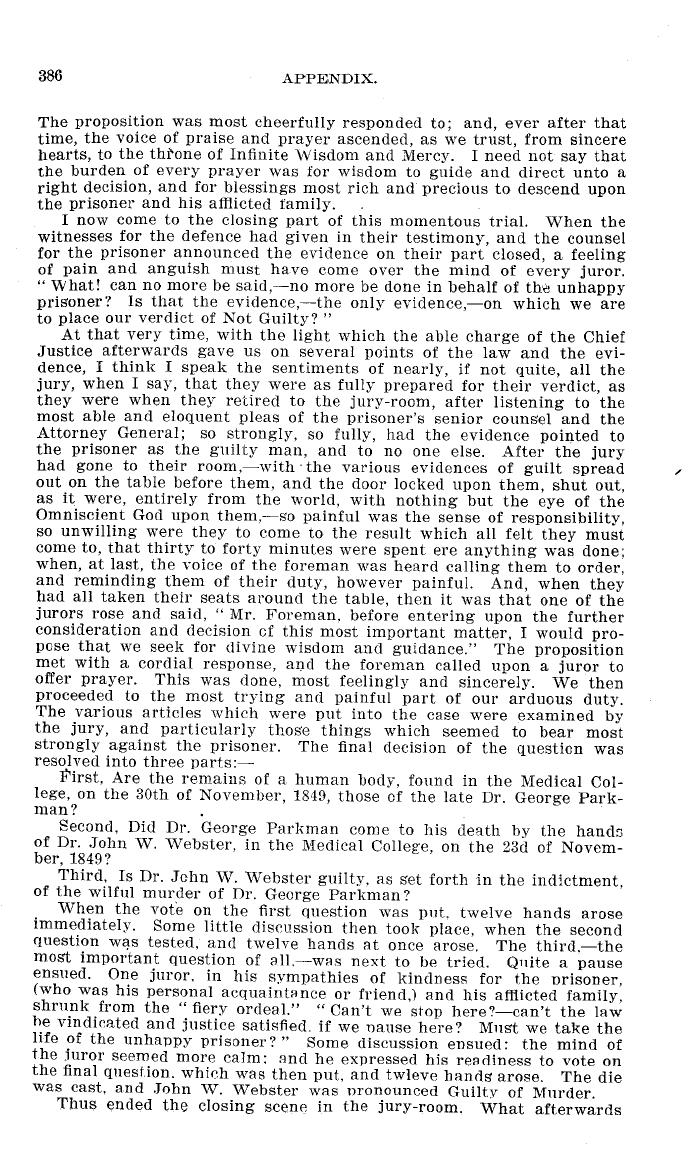|
386 APPENDIX.
The proposition was most cheerfully responded to; and, ever after that
time, the voice of praise and prayer ascended, as we trust, from sincere
hearts, to the throne of Infinite Wisdom and Mercy. I need not say that
the burden of every prayer was for wisdom to guide and direct unto a
right decision, and for blessings most rich and precious to descend upon
the prisoner and his afflicted family.
I now come to the closing part of this momentous trial. When the
witnesses for the defence had given in their testimony, and the counsel
for the prisoner announced the evidence on their part closed, a feeling
of pain and anguish must have come over the mind of every juror.
" What! can no more be said,-no more be done in behalf of the unhappy
prisoner? Is that the evidence,-the only evidence,-on which we are
to place our verdict of Not Guilty? "
At that very time, with the light which the able charge of the Chief
Justice afterwards gave us on several points of the law and the evi-
dence, I think I speak the sentiments of nearly, if not quite, all the
jury, when I say, that they were as fully prepared for their verdict, as
they were when they retired to the jury-room, after listening to the
most able and eloquent pleas of the prisoner's senior counsel and the
Attorney General; so strongly, so fully, had the evidence pointed to
the prisoner as the guilty man, and to no one else. After the jury
had gone to their room,-with the various evidences of guilt spread
out on the table before them, and the door locked upon them, shut out,
as it were, entirely from the world, with nothing but the eye of the
Omniscient God upon them,-so painful was the sense of responsibility,
so unwilling were they to come to the result which all felt they must
come to that thirty to forty minutes were spent ere anything was done;
when, at last, the voice of the foreman was heard calling them to order,
and reminding them of their duty, however painful. And, when they
had all taken their seats around the table, then it was that one of the
jurors rose and said, " Mr. Foreman. before entering upon the further
consideration and decision of this most important matter, I would pro-
pose that we seek for divine wisdom and guidance." The proposition
met with a cordial response, and the foreman called upon a juror to
offer prayer. This was done, most feelingly and sincerely. We then
proceeded to the most trying and painful part of our arduous duty.
The various articles which were put into the case were examined by
the jury, and particularly those things which seemed to bear most
strongly against the prisoner. The final decision of the question was
resolved into three parts:-
hirst, Are the remains of a human body, found in the Medical Col-
lege, on the 30th of November, 1849, those of the late Dr. George Park-
man?
Second, Did Dr. George Parkman come to his death by the handy
of Dr. .John W. Webster, in the Medical College, on the 23d of Novem-
ber, 1849?
Third, Is Dr. John W. Webster guilty. as set forth in the indictment,
of the wilful murder of Dr. George Parkman?
When the vote on the first question was put, twelve hands arose
immediately. Some little discussion then took place, when the second
question was tested, and twelve hands at once arose. The third,-the
most important question of all.-was next to be tried. Quite a pause
ensued. One juror, in his sympathies of kindness for the prisoner,
(who was his personal acquaintance or friend,) and his afflicted family,
shrank from the " fiery ordeal." " Can't we stop here?-can't the law
he vindicated and justice satisfied. if we pause here? Must we take the
life of the unhappy prisoner? " Some discussion ensued: the mind of
the juror seemed more calm: and he expressed his readiness to vote on
the final question. which was then put, and twleve hands arose. The die
was cast, and John W. Webster was pronounced Guiltv of Murder.
Thus ended the closing scene in the jury-room. What afterwards
|

